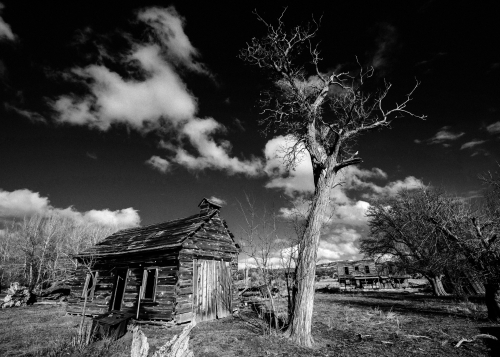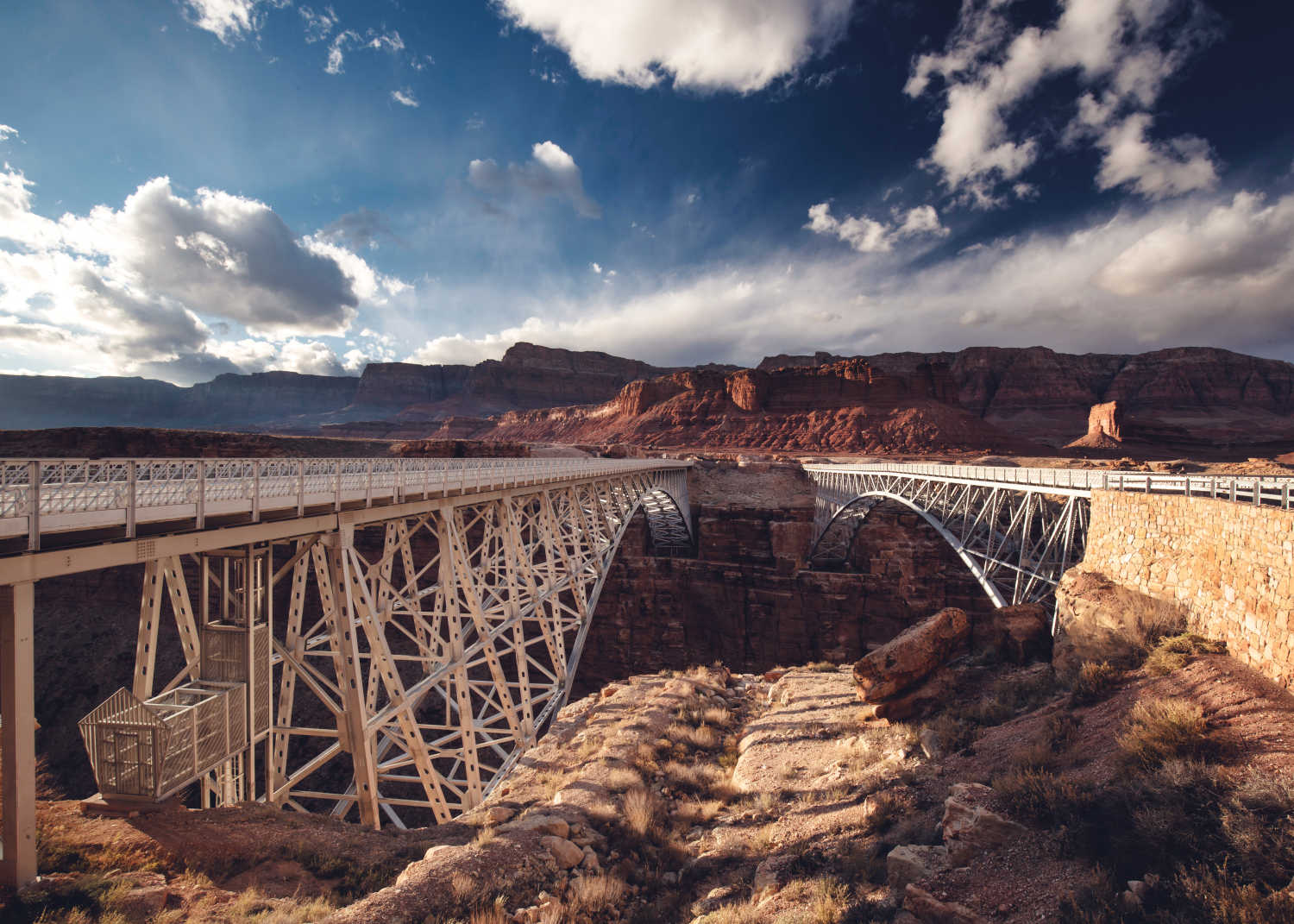Utah ‑ Arizona
This unspoilt landscape boasts a wealth of natural treasures and an abundance of culture. It promises a lifetime of adventure. Summer temperatures in the searing desert soar above 40c; in winter, sub‑zero conditions shroud red rock in a blanket of white snow. Brave explorers of this beautiful environment feel like the first to tread a path as they find a new experience at every turn. The vast stillness of the plains opens the mind. Millions of years of history are the very fabric of the desert. This is the land of discovery.

This landscape is part of me. If I place my hand on the Navajo Sandstone it should be the same colour. Navajo philosophy is that you can’t own land; you are of the land. Nature itself, the air, the smell of rain and the plants after they get wet, even the sound of the wind pushing through my home. All those things are very comforting to me, very relaxing. It’s an experience that needs to be felt, whether it’s the cool brisk air we get during the winter season or the heat that massages you in the summer time.
Raymond M Chee Jr
Full‑blooded Navajo



Zion National Park
An awe‑inspiring display of Navajo Sandstone rock formation, the 229‑square mile Zion National Park is the petrified remains of the largest sand dune desert anywhere, ever. While the dunes of the Sahara are up to 700 ft deep, those of the ancient desert at Zion were massive, wind‑blown dunes as much as 3,000 ft deep.
The most striking characteristic of the rocks in Zion National Park is their brush‑stroke patterns. These cross‑bedded striations are evidence of wind patterns when the rock was still sand, meaning it’s possible to see which way the wind was blowing 200 million years ago while those dunes were being deposited.
Looming above the Great Arch is the East Temple, while visible four miles to the west is the West Temple, the highest mountain in the main park at 7,810 ft above sea level. Both are topped with an additional rock layer called Temple Cap, giving them their distinctive shape.
“ When I look at the rocks, I feel like I’m seeing a story
laid out there in front of me... I see ocean bottom;
I see coastal shorelines; I see the movement of
water and wind"
Lura Snow
Zion Park Trail Guide



Kanab
The friendly Utah town of Kanab is synonymous with the many Westerns filmed in its surroundings but it was also an inspiration behind the fictional town of Radiator Springs in the Pixar animation, Cars. Since the early 80s, legendary Pixar director John Lasseter has driven to his houseboat on Lake Powell via Kanab and is said to have admired the town’s rocky backdrop and the cliff line tracing the road towards Page.
Highway 89 holds a secret between Kanab and Page, where the eerie remains of scrapped cars live on as part of the landscape, stacked in a concealed canyon below the roadside verge as an innovative way of controlling erosion. Evidence of America’s thriving car culture is never far away.
The yards of Glendale offer a fascinating insight into the motoring past, with classic, homegrown metal preserved by this region’s arid climate. Their journeys are over, but they stand as monuments to the automobile’s endless promises of excitement and adventure.

Dennis Judd ‑ Movie Historian



When Hollywood Came to Kanab
Stars to grace the town included John Wayne, Johnny Cash and Rat Pack legends Frank Sinatra, Dean Martin, Sammy Davis Jr, Peter Lawford and Joey Bishop. Kanab’s folk would be hired as extras, horse wranglers or carpenters to help build sets. In 1951 ‘Westward the Women’ was filmed in a set constructed in Johnson Canyon, a few minutes east of Kanab. The dilapidated remains of the cinematic town still stand as a ghostly reminder of Kanab’s illustrious Hollywood history.

Grand Staircase Escalante
Grand Staircase‑Escalante National Monument spans nearly 1.9 million acres of America’s public lands. From its spectacular Grand Staircase of cliffs and terraces, across the rugged Kaiparowits Plateau, to the wonders of the Escalante River Canyons, the Monument’s size, resources, and remote character provide extraordinary opportunities for geologists, palaeontologists, archeologists, historians, and biologists in scientific research, education, and exploration. (US Department of the Interior, Bureau of Land Management)



Over the last 10 years we’ve discovered more than 30 new species of dinosaur in this region... That’s the big addiction for a scientist, that you’re going to find something nobody’s ever seen before. And your chances of doing that out there, in our own back yard, are greater than just about anywhere else in the world.
Dr Alan Titus
Palaeontologist, Grand Staircase Escalante National Monument

Amangiri




Leaving Amangiri, Highway 89 passes alongside a section of the spectacular 1,960‑mile shoreline of the Lake Powell reservoir. Named after the 19th century explorer Major John Wesley Powell who led the first successful survey of the Grand Canyon in 1869, this man‑made scenic and recreational lake can hold a colossal 33 billion cubic metres of Colorado River water.
Glen Canyon Dam
At the western end of Lake Powell sits the imposing Glen Canyon Dam, which holds back the Colorado to form the reservoir. This hydro‑electric dam is 1,560 ft wide at its crest and stands 710 ft tall – making it the second tallest concrete arch dam in the US after the Hoover Dam. Glen Canyon Dam is the centrepiece of the Colorado River Storage Project, established in 1956 to regulate the river’s flow as well as to supply power and water to millions of homes and businesses. Seven‑hundred feet above the Colorado River that continues from the base of the dam is the elegant Glen Canyon Bridge.




Horseshoe Bend
Encased by cliff walls that tower 1,000 ft above the river below, Horseshoe Bend is a natural feature known as an entrenched meander. It was shaped 150 million years ago when the Colorado River first carved a curving route through the soft, easily eroded Carmel Formation rock layer. Once it reached harder rock layers beneath, the river’s course was set and the 270‑degree bend continued to cut the abyss it flows through today.

Formed over millions of years by the combined erosive effects of wind, water and temperature variation, slot canyons offer a bewitching escape from the desert. Flowing, iron‑ and mineralrich stone walls exude a mesmerising red colour that seems to illuminate the secluded canyon interior. Beautiful shapes and natural tarnish on the rock form animal motifs or faces so vivid your smartphone camera will pick them up. Sixty mile‑an‑hour winds blowing through can vary the height of the canyon’s sand floor by as much as 15 ft up or down.
The surface either side of Marble Canyon is the limestone Kaibab Formation, a 270 millionyear‑old sedimentary rock layer. Underfoot in the rock is evidence of a catastrophic event that eliminated 90 per cent of species on the planet within 10,000 years – the blink of an eye in geological terms. No one is certain what caused this mass extinction. The rocks in the canyon below the bridge represent the old world, while the red slopes of the Moenkopi Formation rising above in all directions document a new world.


Vermilion Cliffs
The cliffs to the south once stood alongside the Colorado River but the softer rocks above the Kaibab Plateau have receded from the water, leaving behind the vast plain that 89A crosses. Dominating the epic, big‑sky view for many miles, these majestic walls of rock, which rise to Paria Plateau, were named in 1869 by John Wesley Powell for their vivid red hue.


It’s an experience that needs to be felt, whether it’s the cool brisk air we get during the winter season or the heat that massages you in the summer time.